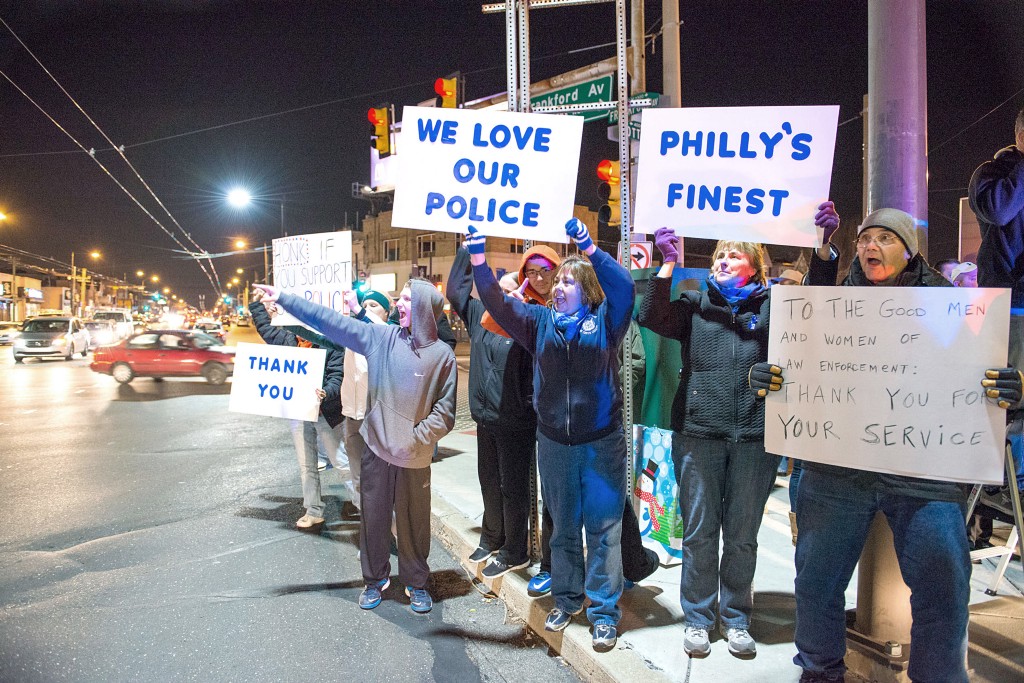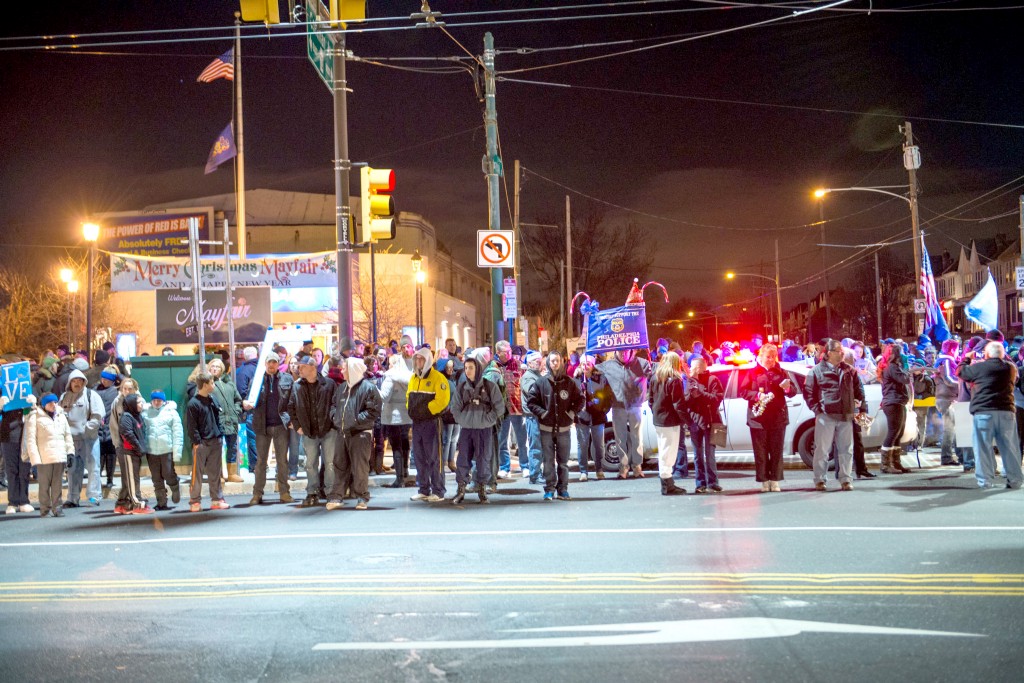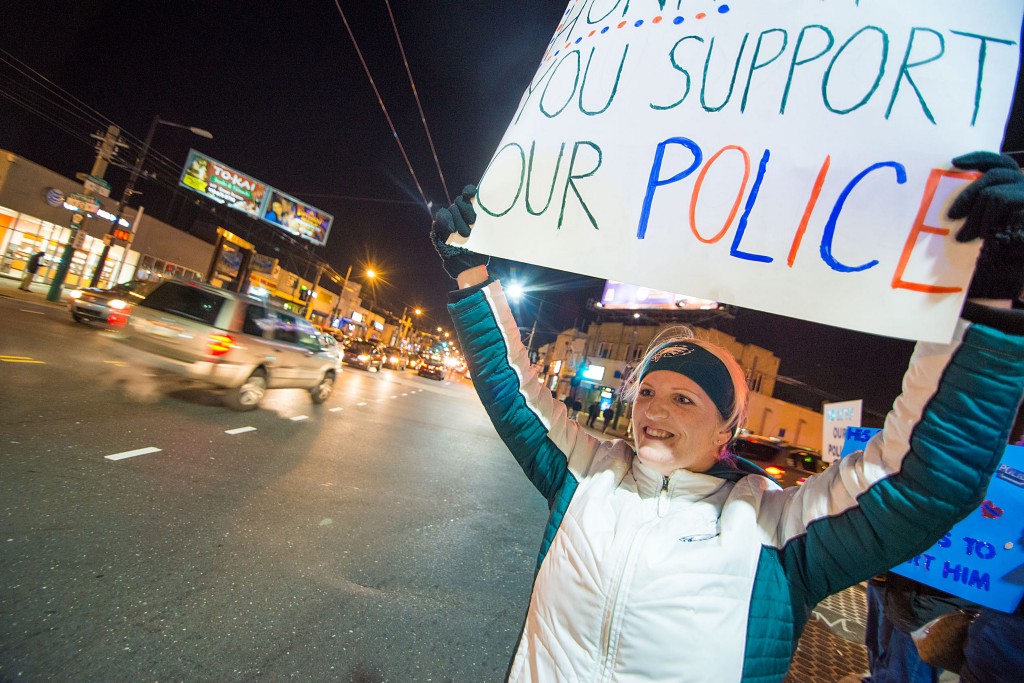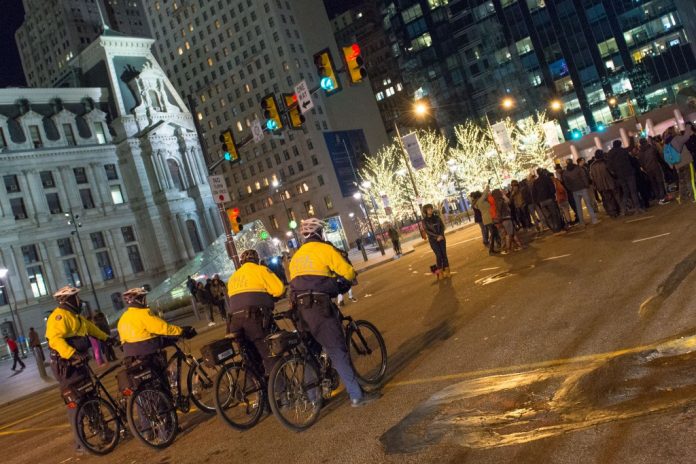Uniformed officers escort peaceful anti-police brutality demonstrators during a march near City Hall on Sunday night.
Hundreds of demonstrators gathered in the heart of Mayfair on Friday evening to offer a new voice in the ongoing national dialogue about police and their use of deadly force. They thanked officers for being community advocates and protectors, and for continuing to answer the call even in the face of mounting public criticism.
It was a purely organic exercise, born from a local man’s modest Facebook invitation several days earlier — he expected that perhaps a dozen relatives and friends might attend. Close to 500 people showed up at Frankford and Cottman avenues with signs, slogans, testimonials and toy donations for sick children.
But the positivity generated by this peaceful affirmation of law enforcement took a major hit hours later when a gunman murdered two apparently random New York City police officers on Saturday afternoon, purportedly to avenge the police-related deaths of Michael Brown in Ferguson, Mo., and Eric Garner in New York earlier this year.
“With the tragic events that happened today in NYC … it shows how much the police need our support! We need to support them EVERYDAY!” wrote Donald Garvey, the creator of the Mayfair rally, in a Facebook post on Saturday night.
In subsequent public comments, Philadelphia Police Commissioner Charles Ramsey acknowledged that the events in New York had escalated the recent debate over police behavior to a new, dangerous level. Ramsey is also the co-chairman of President Obama’s newly created Task Force on 21st Century Policing.
“Right now, everyone needs to lower the volume a little bit on the rhetoric because we’re just in a very, very volatile environment right now,” Ramsey said Monday during an appearance on CBS this Morning.
On Saturday night, Ramsey spoke to local media of the possible influence of anti-police marches and rhetoric on the New York police slayings.
“With some of the people chanting, ‘We want dead cops,’ you just don’t know who that impacts, and now you have two officers dead, leaving behind families,” Ramsey said.
Like New York, Philadelphia has been a center for many legal demonstrations and some illegal acts aimed at drawing attention to a perceived pattern of police brutality. Since grand juries in Missouri and New York separately absolved officers of wrongdoing in the deaths of Brown and Garner, demonstrators have gathered at various locations throughout the city to conduct so-called “die-in” protests, typically employing the “hands up, don’t shoot” and “I can’t breathe” slogans. Students at the University of Pennsylvania conducted one such action at the home of the school president during a holiday party, while other students have done the same at a few city high schools.
Marchers have used downtown streets to share their messages on several occasions, too. One such march began near City Hall on Sunday night and proceeded to the steps of the Philadelphia Museum of Art. Uniformed police escorted the peaceful demonstrators along the way, but reportedly blocked a faction that split from the main group and tried to access the Vine Street Expressway to stop motor traffic.
In the hours before Friday night’s pro-police event, authorities discovered several inflammatory graffiti messages on property in West Philly. On one fence on Baltimore Avenue, someone had spray-painted “Cops Lives Don’t Matter.” The message “PPD Killed Brandon Tate Brown” had been similarly scrawled outside a Catharine Street bar. Nearby, an epithet, “(Expletive) the Cops,” had been painted on an abandoned church. There have been no arrests.
In response to criticism of the Tate-Brown killing, which occurred on Dec. 15 at Frankford and Unruh avenues, Philadelphia police union leader John McNesby called out demonstrators during a Dec. 17 news conference at the Fraternal Order of Police hall. The speech followed a department-sponsored awards ceremony where dozens of officers were honored for valor, bravery and other exceptional actions.
“While it appears to enrage professional hate mongers, the fact is that police officers are covered by the same constitutional protections that they are risking their lives to provide everyone else,” McNesby said. “When our officers are confronted by a convicted, violent felon who should not be out of prison, in possession of a stolen, loaded firearm, what else do you want us to do? We’re not going to call a timeout. We’re not going to call a news hotline.”
As was the case with the Center City marches, dozens of police guarded the Mayfair demonstration on Friday. Inspector Benjamin Naish, commander of the Northeast Division, said that officers were there to maintain the peace and watch out for possible confrontations with counter-protestors. No such conflicts arose. There were no arrests.
The event amounted to the city’s largest pro-police rally since March 2009, when about 4,000 community members marched from the Flyers SkateZone to the 8th Police District and back in the aftermath of the fatal shooting of Officer John Pawlowski, who was the city’s eighth murdered officer in less than three years.
Garvey acknowledged that recent criticism of police nationwide was a motivating factor in Friday’s rally, although criticism of the fatal shooting by Philadelphia police of Tate-Brown, an ex-convict who allegedly was armed and fought officers during a car stop, was not a factor. Tate-Brown, 26, died from a single wound of the head.
“This has nothing to do with the shooting, nothing” Garvey said. “That’s the one thing I need to get across because a lot of people try to twist it. It’s to stand up for the ninety-nine percent of police officers who are positive. I accept that there are corrupt police officers, there are racist police officers, and I don’t stand with them. Nobody does.”
He created the Facebook event page on Dec. 16 after seeing that other communities across the nation were planning similar rallies under the “Step Out in Blue” slogan. Family and friends, including police officers, began sharing the event with others. Soon, the invitation tally grew to more than 17,000 people with some 2,100 indicating they would attend.
“It turned out pretty good,” Garvey said. “There are a lot of people out here. It’s pretty cold, so I don’t think as many people that said they were going to come out came out. I was expecting ten to fifteen people, me and a couple friends and family members with signs.”
Obviously, social media played a major role in his event and has done so in the broader national dialogue.
“That’s not a bad thing,” Garvey said. “Everybody has a right to voice their opinion. That’s the great thing about this country. If you’re for the police, against the police, if you feel good about something or bad about something, you have every right in the world to voice your opinion.”
After the rally, many folks, including cops, took to Facebook to applaud the event.
“As a sergeant in the 15th district, I just want to say thanks to everyone who put this together and showed up by the thousands to support us,” wrote Mike Carr on Facebook. “You have no idea how grateful we are to serve such a supportive community. You have truly lifted our spirits in our time of need.”
“Thank you all for your support,” wrote another cop, Robert Mahan. “I saw the news after I reported off (duty) last night and it almost brought me to tears, almost. It really means a lot to us police. Mayfair Rocks!!” ••

Hundreds of demonstrators showed up at Frankford and Cottman avenues with signs, slogans and testimonials on Friday. The event amounted to the city’s largest pro-police rally since 2009.

Close to 500 people gathered at Frankford and Cottman avenues for a rally to support police officers on Friday.

Bonnie Bell’s sign encourages cars to show their support by honking.

Pro-police: Close to 500 people gathered at Frankford and Cottman avenues for a rally to support police officers on Friday. Mary and Phil Heavy (pictured) carry a flag through the crowd. MARIA POUCHNIKOVA / TIMES PHOTOS





